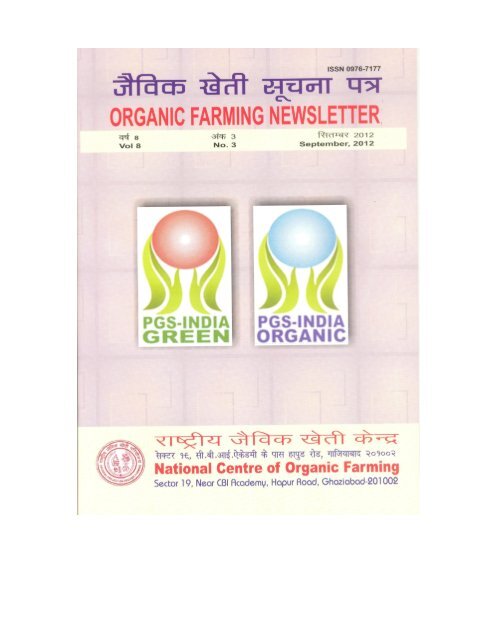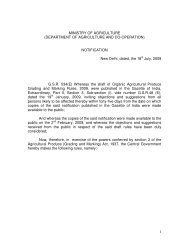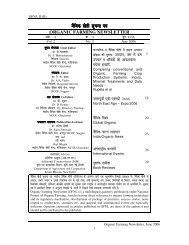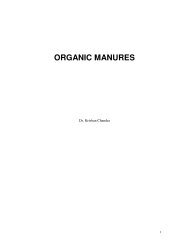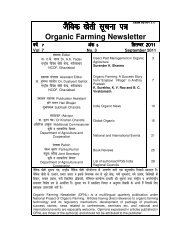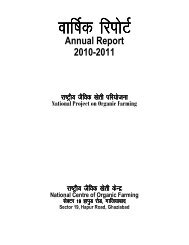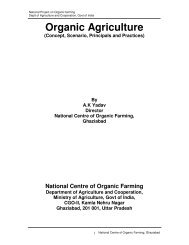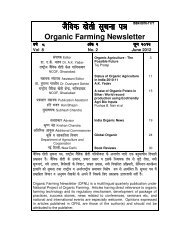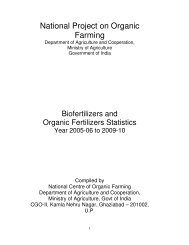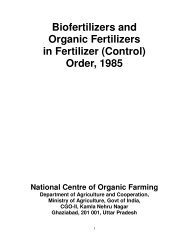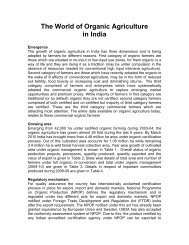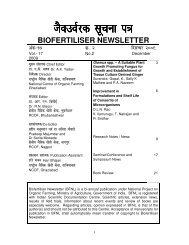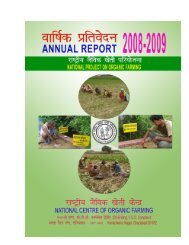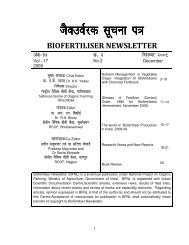September 2012 - National Centre of Organic Farming - dacnet
September 2012 - National Centre of Organic Farming - dacnet
September 2012 - National Centre of Organic Farming - dacnet
Create successful ePaper yourself
Turn your PDF publications into a flip-book with our unique Google optimized e-Paper software.
tSfod [ksrh lwpuk i=] flrEcj <strong>2012</strong> % 8¼3½Impact <strong>of</strong> Some Innovative <strong>Organic</strong> Inputson Soil Properties with and without CropSanjeev Kumari 1* , Jagat Singh 2 P.K. Gupta 31Research Scholar, JJTU, Jhunjhunu, Rajasthan.2 Regional <strong>Centre</strong> for <strong>Organic</strong> <strong>Farming</strong>, Hisar3 <strong>National</strong> Horticultural Research and Development Foundation, NashikIntroductionWith the growing awareness for safe andhealthy food, the demand for organicallygrown food is growing. Concern fordeteriorating soil health and increasingcontamination in ground water and surfacewater bodies have also added to the needfor alternative technologies which not onlycan ensure safe and healthy food but arealso environment friendly and contributing tothe long term fertility and sustainability <strong>of</strong> thesoils. During the last 10 years many farmers,due to various reasons, have switched overto the organic methods <strong>of</strong> cultivation and arenow successfully growing comparableproductivities with much less costs. In theabsence <strong>of</strong> any scientific support majority <strong>of</strong>the farmers relied on the traditional wisdomand with some on-farm experimentation hasdeveloped innovative inputs which can beprepared on-farm with local resources.Among these innovative inputs mostcommon and successful inputs arePanchgavya, Jivamruth and vermiwash.To scientifically evaluate their impact on soilproperties an experiment was carried out atBatar Farm, Hansi, Hisar in Haryana State.The paper briefly describes the impact <strong>of</strong>these innovative inputs on some soilproperties with and without crops.Materials and methodsThe present work was carried out at BatarFarm, Hansi, Hisar during 2011-12 on wheatcrop variety C-306. Details <strong>of</strong> these threeinnovative inputs viz: Panchagavya,Jivamruth and Vermiwash and theirproduction methodology is described below:Panchgavya: Panchagavya is a knowntraditional input among organic farmingfraternity and is being widely used for soilenrichment, plant growth promotion and asprophylactic against some pests. It is madefrom five cow products i.e. –cow dung-5kg,cow urine-2 litre, cow curd-2kg, cow urine-3litre and cow ghee-500 gram. All theseingredients are mixed thoroughly, allowed t<strong>of</strong>erment for one week and then filtered.Jivamruth: It is prepared by mixing cowdung-10kg, cow urine-10litre, Jaggary(Gur)-2kg and Pulse flour- 2kg and fermenting forone week. Filtered extract is used as soilapplication and is believed to enrich soilmicrobiologically through in-numerousbeneficial microorganisms. Jivamruth isreported to contain very large population <strong>of</strong>nitrogen fixers, phosphate solubilizers andsiderophore producers. Microbialfermentation during preparation is alsobelieved to develop some growth promotinghormones which help in better germinationand seedling emergence.Vermiwash: It is the watery extract <strong>of</strong>vermicompost. For its preparation water iscontinuously poured drop-by-drop into acontainer containing the vermin-bed rawmaterial and earthworms. Excess waterdraining out from the bottom tap is collectedas vermiwash.Banyan tree soil: Undisturbed soil collectedfrom the underneath <strong>of</strong> a banyan tree is highin microbial count due to deposition <strong>of</strong>multiple layers <strong>of</strong> biomass and birds andanimal’s excreta and is considered as anexcellent source <strong>of</strong> beneficialmicroorganisms.Application <strong>of</strong> <strong>Organic</strong> inputs- Theseinputs were applied four times @ 50 Kg/Literper ha at 0, 15, 30 and 45 day intervals assoil application in liquid form. Each <strong>of</strong> theseinputs were applied in separate plots withcrop and without crop. Experiment was laid5 <strong>Organic</strong> farming Newsletter, <strong>September</strong> <strong>2012</strong> : 8(3)
tSfod [ksrh lwpuk i=] flrEcj <strong>2012</strong> % 8¼3½Table:7. Average Sulphur <strong>of</strong> the soil samples with and without crop plots.Traditional Inputs Panchagavya Jivamrit vermiwash Banyantree SoilWith crop 150.03 140.40 155.17 114.03Without Crop 132.07 134.13 157.37 138.33ConclusionThe use <strong>of</strong> innovative organic inputsreflected different impact in respect <strong>of</strong>different parameters. Soil pH was found tobe enhanced under all the treatments in thesoil without crop compared to soil with crop.Electrical conductivity was largely unaffectedunder both situations and by any inputtreatment. Total organic carbon and totalnitrogen contents were observed to behigher in all treatments in soils without crop,compared to soils where crop was grownindicating the consumption by the crop.Available phosphorus and available potashwere higher in soils without crop in plotstreated with Panchgavya, Jivamruth andVermiwash while in case <strong>of</strong> Banyan tree soiltreatment the soils with crop showed highervalues. Interestingly available sulfur washigher in soils without crop underPanchgavya and Jivamruth treatment andhigher in soils with crop under Vermiwashand Banyan tree soil treatment.In conclusion, it can be stated that themaximum soil parameter values were foundhigher in soils without crop due to nonuptake <strong>of</strong> minerals by the crop. But in case<strong>of</strong> available Potassium the plots without cropunder Jivamruth and Banyan tree soiltreatment showed lower values compared tosoils with crop. Same was also observed incase <strong>of</strong> Sulphur where Panchgavya andJivamruth treatment showed higher valuesunder crop compared to non-crop soils.Differential behavior <strong>of</strong> different soilparameters indicate that different nutrientsbehaved differently under differenttreatments with and without crops. In soilswhere crop was grown there was netnegative balance with all the treatments inrespect <strong>of</strong> organic carbon, total nitrogen andavailable phosphorus, while there was netpositive balance in respect <strong>of</strong> availablepotassium and sulfur under sometreatments. Rhizospheric interactions maybe responsible for such variable results andneed further exploration <strong>of</strong> the interactions.References:Criticism O.A. report 2008. Compiled by IFOAM(International Federation <strong>of</strong> <strong>Organic</strong>Agriculture Movements), 2008Jackson,M. L.,1975.Soil chemical analysis,practice hall <strong>of</strong> India, New Delhi.Olsen,S.R. Cole, C.V., Watanable, F.S., Dean,L.A.,1954. Estimation <strong>of</strong> available phosphorus insoils by extraction with Sodium Bicarbonate.Circular US department <strong>of</strong> Agriculture, P: 39.Sharma,V., Singh D.,Lal R.(2011), “Effect <strong>of</strong><strong>Organic</strong> Inputs on Seed Yield <strong>of</strong> GobhiSarson(Brassica napus L.)” in <strong>National</strong>symposium cum Brainstorming Workshop on<strong>Organic</strong> Agriculture held at CSK HP,KrishiVishavidalaya, Palmpur19-20 April 2011. pp :97.Simard, R.R., 1993.Ammonium acetateextractable Elements. In:Martin,R.,Carter,S.,(eds) soil sampling and methods <strong>of</strong>analysis. Lewis Publisher, Florida, USA pp.39-43.7 <strong>Organic</strong> farming Newsletter, <strong>September</strong> <strong>2012</strong> : 8(3)
tSfod [ksrh lwpuk i=] flrEcj <strong>2012</strong> % 8¼3½Phosphate Rich <strong>Organic</strong> Manure (PROM) –A Future FertilizerHari Mohan GuptaSociety for <strong>Organic</strong> Agriculture Movement (SOAM)26, Gayatri Nagar-B, Farm, Durgarpura,Jaipur-302018, RajasthanPreambleDeclining fertilizer use efficiency, especially<strong>of</strong> phosphorus, and continuous building <strong>of</strong>insoluble phosphorus reserve in soils is agrowing concern world over and efforts arebeing made to replace the use <strong>of</strong> 100%water soluble phosphorus with that <strong>of</strong>organic carbon linked phosphorus. PROMtechnology, in which natural rock-phosphateis being integrated with organic manuresduring composting process, has emerged assuitable alternative to our needs. PROM hasbeen found to be completely replacing theneed for phosphatic fertilizers. Todemonstrate the benefits <strong>of</strong> using PROM,large numbers <strong>of</strong> field demonstrations wereconducted on farmer’s fields in 4 districts <strong>of</strong>Rajasthan. This paper briefly describes theimpact <strong>of</strong> PROM technology on total yieldand net gains as studied in 8 representativedemonstrations.Methodology used for making PROMFor making PROM sufficient for one ha area200 kg high grade rock phosphate(containing about 30% P 2 O 5 ) was mixed with5 ton <strong>of</strong> cow dung and crop residue mixture.For enhancing the microbial activity 1 kg <strong>of</strong>Azotobacter, 1 kg <strong>of</strong> Phosphate SolubilizingBacteria (PSB) and 0.5 kg <strong>of</strong> Decomposingculture was also added to the mixture asslurry. The mixture was allowed todecompose for 90 days in a pit. After 90days, approximately 3.0 tons <strong>of</strong> maturePROM was harvested, comprising about 30kg N and 60 kg P 2 O 5 . This entire quantity <strong>of</strong>PROM was broadcast spread in the fieldfollowed by ploughing with tractor 15 daysprior to sowing. A parallel control plot wasmaintained at each demonstration sitehaving an area <strong>of</strong> 0.25 ha. The control plotwas treated with either 150 kg DAP or 400kg SSP + 60 kg urea/ha for comparison.Post sowing treatments were similar incontrol as well PROM treated field.ResultsAs is evident from Table 1, the PROM hasyielded higher yields compared to 100%NPK control. The increase in yield wasranging from minimum 3% to maximum10.52%. Net gains in terms <strong>of</strong> additionalincome in PROM treated plots over controlplots were ranging between Rs. 320 and1850 per ha.As the comparison was between PROM andequivalent grade <strong>of</strong> chemical fertilizer, it wasestablished that PROM can be an idealsubstitute for DAP. Study besides providingan alternative to DAP also opens up thescope for reducing the cost on costlychemical fertilizers. The rock phosphateavailable indigenously can very well serveas phosphate resource.Integration <strong>of</strong> phosphorus with organiccarbon not only ensures higher useefficiency <strong>of</strong> applied phosphorus but alsoadd to the biological life <strong>of</strong> the soil besidessaving precious foreign currency andburdening subsidy.8 <strong>Organic</strong> farming Newsletter, <strong>September</strong> <strong>2012</strong> : 8(3)
tSfod [ksrh lwpuk i=] flrEcj <strong>2012</strong> % 8¼3½Table 1. Effect <strong>of</strong> PROM on yield and net gains in Groundnut crop in comparison withchemical fertilizer control.Sl. Name & Address Yield in Kg/ha % Net pr<strong>of</strong>it overNo.Control PROM increase chemicalovercontrolFertilizer in Rs/hector1. Shri Kailash Choudhary Villageand Post-Kiratpura, KotputliJaipur1650 1820 10.30 1820/-2. Shri Girdhari Lal Jat Villageand Post-Kiratpura, Kotputli,Jaipur3. Shri Lal Chand Yadav Villagekasli,Post-kiratpura, KotputliJaipur4. Shri Dharm Singh Village andPost-Kiratpura, Kotputli Jaipur5. Shri Shivram Village and Post-Kiratpura Kotputli Jaipur6. Shri Kailash Village-Jeetpura,Post-Kallawas Lalsoth Dausa7. Shri Prabhu Village-Jeetpura,Post-Kallawas Lalsoth Dausa8. Shri Pusushottam Village-Jeetpura, Post-KallawasLalsoth Dausa1650 1750 06.06 1080/-1950 2150 10.25 1850/-1700 1750 02.90 320/-1600 1750 09.37 1620/-2200 2400 09.09 1500/-2100 2300 09.52 1580/-1900 2100 10.52 1850/-9 <strong>Organic</strong> farming Newsletter, <strong>September</strong> <strong>2012</strong> : 8(3)
tSfod [ksrh lwpuk i=] flrEcj <strong>2012</strong> % 8¼3½Influence <strong>of</strong> Microbial Isolates <strong>of</strong>Beejamruth on Seed Germination andSeedling Vigour Index <strong>of</strong> ChilliNemagoudar M.S., Sreenivasa M.N. and Savita P.Department <strong>of</strong> Agricultural Microbiology,UAS, Dharwad-580005IntroductionNow-a-days organic farming practices aregaining importance as farmers haverealized the benefits <strong>of</strong> organic farming interms <strong>of</strong> soil fertility, soil health andsustainable productivity. Farmers are wellaware with the use <strong>of</strong> organic liquidmanure such as Panchagavya,Beejamruth, Jiwamruth and biodigester inorganic farming. These organic liquidmanures play a key role in promotinggrowth and providing immunity to plantsystem. The spray <strong>of</strong> Panchagavya onchillies produces dark green colour leaveswithin 10days. Its role as plant growthpromoter has already been reported bySubhashini et al (2001) and Sreenivasa etal. Though many farmers are getting betteryield by using organic liquid manures,scientific validation has not been carriedout. Hence an attempt has been made toanalyze the microbial load <strong>of</strong> beejamruthand their influence on seed germinationand seedling vigour index <strong>of</strong> chilli.Material and methodsInitially beejamruth was prepared by usingcow dung and cow urine collected fromdifferent sources like bi<strong>of</strong>arm, diary farmand local cows. The serial dilution andstandard plate count method was usedfor isolation <strong>of</strong> total bacteria, fungi andactinomycetes using respective media i.e.nutrient agar, rose Bengal media andKuster’s agar respectively from differentbeejamruth prepared. The plates wereincubated at 28±2 0 C for one week and thecolony counts were recorded. Theseisolates were screened for their efficiencyand functional characters like IAA (Gordenand Paleg 1957), GA (Paleg,1965)production, nitrogen fixation and P-solubilization capacity (phoshomolybdicblue colour method). Five efficient isolateseach from cow fed with organic feed (frombi<strong>of</strong>arm), exotic breed fed with commercialfeed (from Dairy) and local breed (cow)selected based on N 2 fixing capacity, P-solubilsation and IAA and GA productionwere used for germination study <strong>of</strong> chilliseeds. Germination test was carried out bydipping chilli seeds in respective culturebroth <strong>of</strong> microbial isolates <strong>of</strong> beejamruthafor ten minutes and kept on germinationpaper. On 8 th day, the germinated seedswere counted and the percent germinationwas computed by using the formula. Theshoot length (from collar region to theapex) <strong>of</strong> ten randomly selected ten day oldnormal seedlings was measured and themean was recorded as shoot length incentimeters. The root length betweencollar region and the tip <strong>of</strong> root <strong>of</strong> tenrandomly selected (ten day old normal)seedlings was measured. The mean wascalculated and expressed in centimeters.The seedling vigour index was calculatedadopting the method suggested by Abdul– Baki and Anderson (1973).Seedling vigour index = Germinationpercentage x Seedling length.Ten seedlings were kept in brown paperbags having holes to enable air dryingwere oven dried at 70 o C to achieve10 <strong>Organic</strong> farming Newsletter, <strong>September</strong> <strong>2012</strong> : 8(3)
tSfod [ksrh lwpuk i=] flrEcj <strong>2012</strong> % 8¼3½constant weight. Afterwards, the seedlingdry weight was recorded and expressedas total; dry matter (mg/10 seedlings)Results and discussionOut <strong>of</strong> total bacterial, fungal andactinomycetes isolates from differentbeejamruth, fifteen isolates were selectedfor seed germination and seedling vigorindex test, based on IAA, GA production,N 2 fixation, and P-solubilisation ability(Table I). Among all 16 treatments (Table2), the germination percentage wassignificantly highest in BFBA19 (97.68%)followed by DBA28 (95.07%) while thelowest germination percentage wasobserved in control (82.0%). Seedtreatment with isolates BFF1, LBA22 andBFACT7 resulted in lower germinationpercentage (91.47%, 93.65%and 90.72%)as compared to BFBA19 and DBA28 but itwas higher than control, though they werestatistically on par with each other. Seedtreatment with BFBA19 resulted insignificantly highest root and shoot length(14.13 and 6.25cm.) The lowest root andshoot length was observed in control (9and 4.01 cm) rest <strong>of</strong> all other treatmentswere statistically on par with each butsignificantly differ from BFBA15 (11.00and 5.50 cm) and control (9 and 4.01cm).The seedling vigour index was found to bemaximum in BFBA 19 (1990) while lowestseedling vigour index was observed incontrol (1066). Out <strong>of</strong> 15 isolates selectedfor this study the bacterial isolate BFBA19from bi<strong>of</strong>arm source have shownmaximum germination percentage, rootlength, shoot length, seedling vigour indexand seedling dry weight followed byDBA28 as compared to the other isolateswhile in control lowest germination androot length, shoot length, seedling vigourindex and seedling dry weight (Table2)was observed. This may be due toproduction <strong>of</strong> higher amount <strong>of</strong> IAA andGA by the bacterial isolates fromBeejamruth prepared from cow dung andcow urine from bi<strong>of</strong>arm source. This is inconformity with the findings <strong>of</strong> Nagarajand Sreenivasa (2009) and Sreenivasa etal (2010) that few beneficialmicroorganisms present in beejamruthproduced IAA and GA and resulted inimprovement in seed germination,seedling length and seed vigour insoyabean.ConclusionIn Beejamruth prepared by using cowdungand cowurine collected from Bi<strong>of</strong>arm, dairyfarm and local cow, the isolates <strong>of</strong>bacteria, fungi and actinomycetes frombi<strong>of</strong>arm source showed significantimprovement in the seed germination,seedling vigour and dry matter production<strong>of</strong> chilli.ReferencesAbdul- Baki, A.A. and Anderson, J.D. (1973)Vigour determination in soybean seed bymultiple criteria. Crop Sci. 13: 630-633Gorden, S.A. and Paleg, L.G. 1957, Quantitativemeasurement <strong>of</strong> indole acetic acid. PlanPhysiol, 10:37-48.Nagaraj M.N. and Sreenivasa, M.N, 2009,Influence <strong>of</strong> bacteria isolated fromPanchagavya on seed germination and seedvigour in wheat. Karnataka J Agric. Sci., 22(1): 231-232.Paleg, L.G., 1965, Physiological effects <strong>of</strong>Gibberellins. Ann. Rev.Plant Physiol.,16 :291-322.Sreenivasa. M.N. Nagaraj Naik and S.N. Bhat.(2009). Beneficial traits <strong>of</strong> microbialisolates <strong>of</strong> organic liquid manures - FirstAsian PGPR Congress for sustainableagriculture – 21-24, June 2009, ANGRAU.Hyderabad.Sreenivasa . M.N., Nagaraj Nasik and S.N. Bhat.2010, <strong>Organic</strong> liquid manures: Source forbenefical microorganisms and plantnutrients. <strong>Organic</strong> <strong>Farming</strong> Newsletter6(4):113.Subhashini S, A. Arumugasamy, K. Vijaylakshmiand A.V Balasubramanian (2001).Vrkshayurveda- Ayurveda for plants. <strong>Centre</strong>for Indian Knowledge Systems, Chennai,Tamil Nadu.pp 47.11 <strong>Organic</strong> farming Newsletter, <strong>September</strong> <strong>2012</strong> : 8(3)
tSfod [ksrh lwpuk i=] flrEcj <strong>2012</strong> % 8¼3½Table 1 : Best five efficient isolates selected each from beejamruth prepared by using Cowdung and cow urine obtained from Bi<strong>of</strong>arm , Dairy farm and Local cow based on N2 fixing,P-solubilising. IAA and GA producing capacitySr,No.IsolatesN2 fixation(mg NH 4 +/gC utilized)PSolubilization(%Pi releasedfrom TCPBFBA = Bi<strong>of</strong>arm Bacteria , DBA = Dairy Bacteria, LBA = Local BacteriaBFF = Bi<strong>of</strong>arm Fungi , DFF = Dairy farm fungi , LFF= Local fungiBFACT = Bi<strong>of</strong>arm Actinomycetes, DFACT = Dairy farm ActinomycetesIAA(ug/25ml)GA(ug/25ml)1 BFBA15 13..25 6.25 10.54 4.382 BFBA19 13.58 6.50 10.42 4.273 DBA 28 12.86 5.56 9.16 4.134 DBA 30 11.34 5.49 9.58 4.195 LBA22 8.50 4.17 8.13 4.006 BFACT 7 7.89 5.90 6.45 2.357 BFACT 14 6.56 5.65 6.28 2.288 DACT 4 6.78 5.50 5.98 2.269 DACT18 7.65 5.13 5.56 2.1510 LACT14 4.05 3.18 4.20 2.0111 BFF1 0 9.25 7.98 3.5512 BFF6 0 7.39 7.76 3.2813 DFF11 0 8.28 6.83 3.1914 DFF18 0 9.13 6.68 3.1515 LFF3 0 6.72 6.50 3.02S.E.m+-CD(P=0.01)0.090.260.070.210.080.240.040.11Table 2-Influence <strong>of</strong> efficient isolates <strong>of</strong> beejamruth on germination <strong>of</strong> chilli seedsS Isolates Seed Root Shoot Seedling Seedling SeedlingN.germina length length length vigour dry weighttion andpercent(cm) (cm) (cm) index (mg/10seedling)age%1 BFBA15 88.13 11.00 5.50 16.50 1458 33.712 BFBA19 97.68 14.13 6.25 20.38 1991 46.033 DBA 28 95.07 12.55 6.00 18.57 1765 40.824 DBA 30 87.82 11.50 5.00 16.50 1453 33.55 LBA22 93.65 11.83 5.11 16.94 1586 36.686 BFACT 7 90.72 10.47 5.23 15.70 1424 32.937 BFACT 14 84.30 10.22 5.20 15.42 1301 30.088 DACT 4 85.30 10.50 5.01 15.50 1323 30.609 DACT18 86.00 10.50 5.50 16.00 1377 31.8310 LACT14 83.70 9.78 4.50 14.28 1195 27.6011 BFF1 91.47 10.76 5.51 16.26 1487 34.3912 BFF6 86.00 10.13 5.02 15.15 1304 30.1413 DFF11 87.59 10.00 4.50 14.50 1270 29.3214 DFF18 89.30 9.75 4.62 14.37 1283 29.6715 LFF3 86.50 9.53 4.50 14.03 1214 28.0616 Control 82.00 9.00 4.01 13.00 1066 24.64SEm ±CD (P=0.01)1.012.910.120.360.060.170.180.5216.2662.990.381.0812 <strong>Organic</strong> farming Newsletter, <strong>September</strong> <strong>2012</strong> : 8(3)
tSfod [ksrh lwpuk i=] flrEcj <strong>2012</strong> % 8¼3½India <strong>Organic</strong> NewsSatyamev Jayate: <strong>Organic</strong> farming, need<strong>of</strong> the hour - Did you know that there are 67types <strong>of</strong> pesticides which are banned allover the world, but are still used by Indianfarmers. Everyday, through fruits andvegetables, we consume 400-500% morepesticides than the permissible limit. AamirKhan highlighted the bad effects <strong>of</strong> chemicalfarming during the eighth episode <strong>of</strong> histelevision show ‘Satyamev Jayate’. Hespoke to doctors, agricultural scientists,farmers and others during the episode. Toincrease productivity, farmers have beenusing pesticides for agricultural purposesfrom years now. Because <strong>of</strong> this, thenutritional value <strong>of</strong> the crop goes down.Now, these pesticides have become a part<strong>of</strong> our food chain. According to a study by DrRashmi Sanghi, even breast milk contains400-800% more pesticides than thepermissible limits. During the show, manyfarmers confessed that they do not usethese pesticides for the fruits and vegetablesthey separately grow for their ownconsumption. Jurnail Singh a farmer fromJajjal, Punjab claims that excessive use <strong>of</strong>pesticides started after the GreenRevolution. Aamir tried to highlight thebenefits <strong>of</strong> organic farming and alternateways <strong>of</strong> killing insects during the show. Frommany years, agricultural scientist Dr GVRamanjaneyulu has been working with thefarmers in Andhra Pradesh to teach themcheap and safe ways <strong>of</strong> getting rid <strong>of</strong> theinsects. He said, “Not pests, but pesticidesare a bigger problem for the farmers. On anaverage, a village spends nearly Rs 50 lakhevery year on pesticides.” Aamir Khan alsospoke to Pawan Chamling, chief minister <strong>of</strong>Sikkim on the show. Chamling has bannedall pesticides in the state and is promotingorganic farming. He aims to make Sikkim anorganic state by 2015. It is not possible forall the states to switch to organic farmingovernight, but taking some steps to savepeople’s life is essential now. Through hisshow, Aamir urged audiences to opt fororganic products. He also said that thereshould be a regulating body to monitor theusage <strong>of</strong> pesticides by the farmers.<strong>Organic</strong> and inorganic cultivation <strong>of</strong> chilliand its marketing- An economic analysis- The present study was conducted inBelgaum district, the major vegetableproducing district <strong>of</strong> north Karnataka. Largenumbers <strong>of</strong> farmers practice the organiccultivation <strong>of</strong> chilli in the district. For thestudy, 30 farmers each practice in organicand inorganic cultivation <strong>of</strong> chilli spread overthe district <strong>of</strong> Belgaum were selectedrandomly. The data collectedfrom respondents was analyzed usingbudgeting technique. The estimated per acrecost <strong>of</strong> cultivation <strong>of</strong> organic and inorganicchilli was ` 18337.00 and `19115.00respectively. Per acre average yield <strong>of</strong>organic chilli was 4.10 tonnes as against4.86 tonnes in inorganic chilli. Per tonnemarket prices for organic and inorganic chilliwere Rs 9830.00 and Rs 6300.00,respectively. Transportation cost includingloading and unloading for organic chilli was `265.00 per tonne as against ` 285.00 forinorganic chilli. The per tonne commissioncharges for organic and inorganic chilli wereRs 644.00 and Rs 432.00, respectively. Thetotal marketing cost per acre for organic chilliwas Rs 3726.00 as against Rs 3485.00 forinorganic chilli. The gross returns <strong>of</strong>organic chilli were Rs 40290.00 per acre asagainst Rs 30583.00 for inorganic chilli. Thenet returns <strong>of</strong> organic chilli (Rs. 18227.00)were higher than that <strong>of</strong> inorganic chilli (Rs7984.00). The B:C for organic chilli was 1.83as against 1.35 for inorganic chilli. Hence itis advisable for the farmers to switch over toorganic farming which minimizes theenvironmental degradation and alsobrings higher net returns (Source-Naik et alKarnataka Journal <strong>of</strong> AgriculturalSciences, Vol 25, No 2 (<strong>2012</strong>)Effect <strong>of</strong> organic farming on productivity,soil fertility and economics <strong>of</strong> scentedrice-tomato–bottle gourd croppingsystem - Field experiments were conductedduring 2006–2009 to study the effect <strong>of</strong>various organic sources (computed on 150kg ha −1 N-equivalent basis) forming seventreatments, viz. Azotobacter + FYM, FYM,Goat manure, Vermicompost, Azolla + FYM13 <strong>Organic</strong> farming Newsletter, <strong>September</strong> <strong>2012</strong> : 8(3)
tSfod [ksrh lwpuk i=] flrEcj <strong>2012</strong> % 8¼3½and cow urine along with no application(control) in rice (cv Sugandha) and theirresidual effect on productivity <strong>of</strong> tomato(Swarna Lalima) and bottle gourd (ArkaBahar) crops, soil fertility and economics <strong>of</strong>the cropping system. The highest rice grainyield <strong>of</strong> 2.68 t ha −1 was recorded with Azolla+ FYM which was at par with vermicompost(2.55 t ha −1 ), Azotobacter + FYM (2.41 tha −1 ) and FYM (2.37 t ha −1 ). Among differentorganic sources the rice grain yield wassignificantly lower under goat manure andcow urine. However, vermicompost recordedsignificantly highest yield <strong>of</strong> tomato as wellas bottle gourd which was at par withAzotobacter + FYM and FYM treatment.Maximum net return <strong>of</strong> Rs. 3,11,958 ha −1with 3.59 benefit : cost ratio was obtained byvermicompost. It was followed by net return<strong>of</strong> Rs.2,98,628/-and B: C ratio <strong>of</strong> 3.42 byAzotobacter + FYM and net return <strong>of</strong> Rs.2,77,298/-and B: C ratio <strong>of</strong> 3.25 by FYM alonetreatment. The continuous application <strong>of</strong> allthe organic sources to rice for three yearssignificantly improved the soil-organiccarbon, available N, P and K status at theend <strong>of</strong> the cropping system. (Source-Singh S. K. 2011,(online-May, <strong>2012</strong>),International Journal on Rice, Volume : 48,Issue : 4),Nutrient status <strong>of</strong> soil under differentnutrient and crop management practices-A field experiment was conducted duringkharif and rabi seasons <strong>of</strong> 2007-08 at UAS,Dharwad, Karnataka to study the effect <strong>of</strong>organic, chemical and integrated nutrientmanagement (INM) practices on soil fertilitystatus in soybean-wheat, groundnutsorghum,maize-chickpea, potato-chickpeaand chilli + cotton systems. The presentstudy was the fourth year <strong>of</strong> long term fieldexperiment (LTFE) <strong>of</strong> Network Project on<strong>Organic</strong> <strong>Farming</strong> at Institute <strong>of</strong> <strong>Organic</strong><strong>Farming</strong>, UAS, Dharwad. After harvest <strong>of</strong>kharif crops <strong>of</strong> fourth year (2007-08), theintegrated nutrient management practicerecorded significantly higher available N(278.4 kg/ha), P 2 O 5 (23.4 kg/ha), K 2 O (355.0kg/ha) and S (18.7 kg/ha) when compared tochemical nutrient management practice.Similarly, DTPA extractable Zn, Fe, Mn andCu were significantly influenced byintegrated nutrient management practice(1.46, 7.96, 9.67 and 0.89 mg/kg,respectively). At the end <strong>of</strong> fourth <strong>of</strong> LTFE,there was increase in available N by 19.0,P 2 O 5 by 46.3, K 2 O by 9.6 and S by 54.1 percent respectively due to INM. SimilarlyDTPA extractable Zn, Fe, Mn and Cuincreased by 18.5, 30.6, 36.5 and 30.0 percent respectively due to integrated nutrientmanagement practice over their initialvalues. The available N, P 2 O 5 , K 2 O and Swere significantly higher in legume basedcropping systems during both the season <strong>of</strong>the study than non legume system. (Source-Vidyavati, G. S. Dasog, H. B. Basalad, N. S.Hebsur, S. K. Gali S. G. Patil and A. R.Alagawadi <strong>2012</strong>, Karnataka J. Agric. Sci.,25(2) : 193-198)Importance <strong>of</strong> KUNAPAJALA (TraditionalLiquid <strong>Organic</strong> Manure) <strong>of</strong>VRIKSHAYURVEDA In medicinal plantcultivation - Medicinal plants play animportant role not only as traditionalmedicine but also as trade commodities.With depleting natural resources, cultivation<strong>of</strong> medicinal plants has become the need <strong>of</strong>the hour to meet the growing demand <strong>of</strong>herbal drug requirement in the field <strong>of</strong>medicine. But using chemicals in the form <strong>of</strong>pesticide and fertilizers may haveundesirable impact on the quality <strong>of</strong> theseplants as well as human health. Recentlyvarious state Governments in India havecome up with different schemes to cultivatemedicinal plants through organic farmingand under Good Agricultural Practices(GAP). “Vrikshayurveda” a sub branch <strong>of</strong>Ayurveda describes a particular type <strong>of</strong>liquid organic manure called “Kunapajala” forthis purpose. Scattered references are foundregarding the effect <strong>of</strong> Kunapajala onmedicinal plant cultivation. This reviewhighlights the importance <strong>of</strong> organic farmingand results <strong>of</strong> research works carried out onthe effect <strong>of</strong> Kunapajala on medicinal plantcultivation. (Source- Bhat Savitha D, AshokB K, Acharya Rabinarayan, and Ravishankar<strong>2012</strong>, Global Journal <strong>of</strong> Research onMedicinal Plants & Indigenous MedicineGJRMI, Volume 1, Issue 7, July <strong>2012</strong>, 272–279).Long-term effect <strong>of</strong> nutrient managementon soil fertility and soil organic carbon14 <strong>Organic</strong> farming Newsletter, <strong>September</strong> <strong>2012</strong> : 8(3)
tSfod [ksrh lwpuk i=] flrEcj <strong>2012</strong> % 8¼3½pools under a 6-year-old pearl millet–wheat cropping system in an Inceptisol<strong>of</strong> subtropical India –Long term studieswere conducted to study the effect <strong>of</strong>nutrient management on soil fertility and soilorganic carbon (SOC) pools under a 6-yearoldpearl millet–wheat cropping system in anInceptisol <strong>of</strong> subtropical India. Significantbuild-up in soil fertility in terms <strong>of</strong> alkalineKMnO 4 -N, Olsen-P, NH 4 OAc-K and CaCl 2 -Sas well as SOC pools namely, total organiccarbon (TOC), Walkley and Black organiccarbon (WBC), labile organic carbon (LBC)and microbial biomass carbon (MBC) weremaintained under FYM and integratednutrient management involving FYM andNPK than unfertilized control plot in 0–15and 15–30 cm soil depths. The highestvalues <strong>of</strong> TOC (11.48 g kg−1) and WBC(7.86 g kg−1) were maintained in FYMtreated plot, while the highest values <strong>of</strong> LBC(1.36 g kg−1) and MBC (273 mg kg−1) werefound in FYM + NPK. The magnitude <strong>of</strong>change in pools <strong>of</strong> SOC in sub-surface (15–30 cm) soil was low as compared to thesurface soil (0–15 cm). Significant increasein all the pools <strong>of</strong> SOC in FYM treated plotsindicates the importance <strong>of</strong> application <strong>of</strong>organic manure like FYM in maintainingorganic carbon in soil. Highly strongrelationships were exhibited between LBCand MBC with yield, indicating that thesepools are more important for nutrient turnoverand their availability to plants than totalSOC. Carbon management index revealedthat integrated nutrient management couldbe followed for enhancing crop productivity,nutrient availability and soil carbon pools forlong-term. These results conclude that forsustainable crop production and maintainingsoil quality, input <strong>of</strong> organic manure likeFYM is <strong>of</strong> major importance and should beadvocated in the nutrient management <strong>of</strong>intensive cropping system for improving soilfertility and biological properties <strong>of</strong> soils.(Source- Moharana, et al, (<strong>2012</strong>) FieldCrops Research, 136. pp. 32-41)Sequestering carbon through organicmulch- Today’s changing lifestyle has anenormous impact on the environment andalso has an effect on climate change.According to a recent survey, theconcentration <strong>of</strong> carbon dioxide in theatmosphere is 395.77ppmv (parts per millionby volume) whereas the upper limit foratmospheric CO 2 is only 350ppmv. Climatechange has become one <strong>of</strong> the majorchallenges for mankind and the naturalenvironment. The study reveals that 1kg <strong>of</strong>carbon released from the soil constitutes3.64kg <strong>of</strong> CO 2 in the atmosphere. Thereforesoil is one <strong>of</strong> the largest reservoirs, wherecarbon could be restored. Carbonsequestration in terrestrial ecosystem hasbeneficial effects at small levels. The idea isto prevent carbon emitted due to humanactivities from reaching the atmosphere bycapturing and storing them. <strong>Organic</strong> mulch,a type <strong>of</strong> compost made from decayingplants or trees, claims to be one <strong>of</strong> the mostsustainable approaches in sequesteringcarbon. It aims at covering the soil with anynatural organic matter. The method involvesapplying compost or farm yard manure overthe soil surface followed by adding a layer <strong>of</strong>dry organic matter over it. Then a layer <strong>of</strong>green organic matter is applied to maintainmoisture and improve organic carbon in thesoil. Here, the compost contains an array <strong>of</strong>beneficial microbes, where the dry matter isrich in carbon and the green matter is rich innitrogenous substances. Whendecomposition <strong>of</strong> these components takesplace the carbon nitrogen ratio in the soilbecomes 10:1, ideal for the proliferation <strong>of</strong>microbes. In addition, it reducesevaporation, enhances water infiltration andprevents topsoil from being washed awaydue to water run <strong>of</strong>f. Soil managementpractices have the potential to createconsiderable carbon sinks, if good farmingpractices like mulching are employed.(Source- J.K.Mohan Kumar writer is ascience teacher at Chettinad Public School,Managiri, Karaikudi. He has done researchon herbal remedies and has been practicingorganic farming for 10 years. )Solitary cow can help in cultivation <strong>of</strong> 30acres- K. Gangadharam, a progressiveorganic farmer from Chittor district said thatit is possible to cultivate 30 acres <strong>of</strong>agricultural land with the dung and urine <strong>of</strong> asingle country cow without depending onfertilizers and pesticides. Jiwamrutam, aliquid prepared from cow dung and urine andGhanamrutam, a material in dry form15 <strong>Organic</strong> farming Newsletter, <strong>September</strong> <strong>2012</strong> : 8(3)
tSfod [ksrh lwpuk i=] flrEcj <strong>2012</strong> % 8¼3½prepared from same material from just onecow is sufficient to cultivate 30 acres <strong>of</strong> landwhich would also reduce the burden <strong>of</strong>purchasing expensive chemicals andfertilizers. According to him a country cowproduces 10kg <strong>of</strong> dung and 10litres <strong>of</strong> urineper day which is enough to cultivate thefarmland by many small and marginalfarmers. The cow dung and urine should bemixed with 2kg jaggery, 2 kg pulse powder,a small quantity <strong>of</strong> bund soil and 200litre <strong>of</strong>water. This will become Jiwamrutam in 48hrs. It can be supplied once in a monthalong with irrigation water to the farmlandwhich is sufficient to get a good yield <strong>of</strong>any crop. About 500 farmers in ChittorDistrict are following this practice in about300 acres <strong>of</strong> land and the results areencouraging. While, some are gettingmaterial from others and some farmers arein process <strong>of</strong> purchasing cows for theirfarms. According to K. Gangadharam many<strong>of</strong> these farmers believed that they can get agood crop yield only after using chemicalfertilizers and pesticides which actually isdetrimental to soil health. It will take somemore time to convince the farmers to switchto more environment friendly practices(Source-The Hindu, Wednesday, June 6,<strong>2012</strong>).NATIONAL CENTRE OF ORGANIC FARMINGKAMLA NEHRU NAGAR, GHAZIABADPr<strong>of</strong>orma <strong>of</strong> application for Subscription <strong>of</strong> Newsletter/ Change in Mailing AddressTo,The Director,<strong>National</strong> <strong>Centre</strong> <strong>of</strong> <strong>Organic</strong> <strong>Farming</strong>,Hapur Road, Near CBI Academy,Kamla Nehru Nagar,Ghaziabad-201 002.Subject : Request for Subscription <strong>of</strong> Newsletter/ Change in mailing address – regarding.Subs. No. : _____________________ (if request is for change in mailing address).Sir,I wish to subscribed Bi<strong>of</strong>ertiliser Newsletter (BFNL – Half Yearly)/ <strong>Organic</strong> <strong>Farming</strong>Newsletter (OFNL – Quarterly) being published by your organization. Kindly include the followingaddress in your mailing list for the subscription <strong>of</strong> aforesaid newsletter(s).Name : ________________________________________________________________Designation : ___________________________________________________________Office/Residence address : __________________________________________________________________________________________________________________________________________________________________District : ______________________________________Pincode _________________State : ________________________________________________________________Telephone No. (Office)___________________________ (Resi) __________________Fax No.: ________________________________ E-mail : _______________________Field <strong>of</strong> Interest/work : __________________________________________________Yours faithfully,Date : ______________Place : ______________Signature ________________Name ___________________16 <strong>Organic</strong> farming Newsletter, <strong>September</strong> <strong>2012</strong> : 8(3)
tSfod [ksrh lwpuk i=] flrEcj <strong>2012</strong> % 8¼3½Two Days <strong>National</strong> Seminar on<strong>Organic</strong> and Biological Inputs – New Innovationsand Quality ControlTwo days <strong>National</strong> seminar entitled “<strong>National</strong>Seminar on <strong>Organic</strong> and Biological Inputs –New Innovations and Quality Control’ wassuccessfully organized during 18-19 th July,<strong>2012</strong> by the <strong>National</strong> <strong>Centre</strong> <strong>of</strong> <strong>Organic</strong><strong>Farming</strong>, Department <strong>of</strong> Agriculture andCooperation, at its new premises located at19, Hapur Road, Ghaziabad – 201 002,Uttar Pradesh, India. The aim <strong>of</strong> the seminarwas to identify potential technologies andinputs, define minimum ingredients, bioefficacyand bio-safety requirement for newinputs and to formulate strategies fordefining their practically achievable qualityparameters with necessary methods forundertaking such tests. All interested peoplefrom different institutions and organizationswere invited for participation in this seminar.The Seminar forum comprised nearly 200participants from different states in country.The seminar was inaugurated by theAdditional Secretary, Department <strong>of</strong>Agriculture, Government <strong>of</strong> India, Shri ShirajHussain. The distinguished guestspresented on the dias during inauguralceremony included Shri NarendraBhooshan, Joint Secretary (INM), DAC, Govt<strong>of</strong> India, Shri Ardhendu Sen former ChiefSecretary, Govt <strong>of</strong> West Benagl andCurrently Director, TERI, Dr. L.N. Verma andDr. P. Bhattacharyya, former DirectorsNCOF, Dr. Krishan Chandra, AdditionalCommissioner (INM), DAC and Dr. A.K.Yadav, Director NCOF. The Chief Guestwhile inaugurating the seminar lauded theefforts <strong>of</strong> NCOF for successful launch <strong>of</strong> theseminar and stressed that the country needto put in lot <strong>of</strong> innovations for ensuring highquality organic inputs and their qualitycontrol. Shri Narendra Bhooshan underlinedthe importance <strong>of</strong> organic farming in theyears to come and requested the scientificfraternity to concentrate on the efforts fordeveloping appropriate packages forobtaining optimum yields from organicmanagement systems. Shri Ardhendu Senelaborated in the India organic story andclarified that the present day organicagriculture is keeping the pace with time andjust 10% behind the conventional, in spite <strong>of</strong>the fact that country has not made anyinvestments in this direction. If adequateinvestments in terms <strong>of</strong> research anddevelopment are made this gap can befilled. Inaugural ceremony concluded withthe vote <strong>of</strong> thanks by Dr. Krishan Chandra.A book dedicated to the occassion entitled“<strong>Organic</strong> and Biological Inputs – NewInnovations and Quality Control” was alsoreleased during the inaugural session by theChief Guest. The publication comprised <strong>of</strong>latest innovations and quality controlinitiatives in the field <strong>of</strong> organic andbiological inputs.The Seminar forum comprising <strong>of</strong> nearly 200participants from different States deliberatedon wide range <strong>of</strong> issues starting fromorganic farming as a whole, its relevance,constraints being faced and its potential infood security to various organic andbiological inputs, new innovations andquality control. Half <strong>of</strong> the technical sessionswere concentrated on new organic andbiological inputs, their bio-efficacy and activeingredients. Mechanisms <strong>of</strong> actions <strong>of</strong> somelesser known inputs were also discussed.Efforts taken up by the NCOF in defining thequality parameters for some inputs werelauded by the participants and industryrepresentatives and suggested that suchinitiatives need to be continued forcontinuous up gradation <strong>of</strong> quality controlscenario.After thorough deliberations the eminentpanelists during valedictory session framedfollowing recommendations with the requestthat Department <strong>of</strong> Agriculture andCooperation, Ministry <strong>of</strong> Agriculture maykindly focus the strategy in 12 th plan onsuggested key issues for the focused17 <strong>Organic</strong> farming Newsletter, <strong>September</strong> <strong>2012</strong> : 8(3)
tSfod [ksrh lwpuk i=] flrEcj <strong>2012</strong> % 8¼3½promotion <strong>of</strong> organic farming in general andpromotion <strong>of</strong> various organic and biologicalinputs in particular.1. General recommendations forResearch and Education - On review <strong>of</strong>various research results it has beenrevealed that in spite <strong>of</strong> practically noinvestment in research and development themodern organic is not very far behind theconventional agriculture in terms <strong>of</strong> yield.While many studies claim that organicmanagement is capable <strong>of</strong> yielding similarproductivity, some studies have indicatedreduction in yield to the tune <strong>of</strong> 10%. Thisclearly indicates that organic agriculture inspite <strong>of</strong> being a neglected field in researchand development and practically noinvestment in terms <strong>of</strong> subsidies is just 10%behind the conventional agriculture. Thisgap can be filled through appropriate policyregime, investment in input productioninfrastructure and development <strong>of</strong> practicesand packages through research. Afterthorough deliberation on these issuesfollowing suggestions are made for theconsideration <strong>of</strong> DAC and ICAR.i. To support the subject with continuousresearch, there is an urgent need for adedicated “<strong>National</strong> Research <strong>Centre</strong> on<strong>Organic</strong> <strong>Farming</strong> Research”. Out comefrom “Network Project on <strong>Organic</strong> <strong>Farming</strong><strong>of</strong> ICAR” are so far limited and coverslimited aspects.ii. DAC and ICAR should support at least oneState Agricultural University (SAUs) ineach state for launching “<strong>Centre</strong> <strong>of</strong>Excellence on <strong>Organic</strong> <strong>Farming</strong>”.iii. Universities also need to be encouragedfor including at least 2-3 credits on organicfarming in their undergraduate syllabus.iv. DAC and ICAR can also provide necessaryassistance to SAUs for starting specializedDegree/ diploma courses in organicfarming.v. DAC may take up discussion on theseissues with ICAR and include organicfarming as priority issue in DAC-ICARinterface meetings for time to timemonitoring <strong>of</strong> decisions made.2. Adoption <strong>of</strong> organic farmingpromotion policy by Central Government- It was noted that while many small andsome <strong>of</strong> the large states have definedpolicies for promotion <strong>of</strong> organic farming; thecentral Government has yet to adopt anypolicy initiative. For promotion <strong>of</strong> any issue<strong>of</strong> national importance, it is essential that thesubject is part <strong>of</strong> the national Policy. Thepanelists and experts on the occasionstrongly suggested that the Department <strong>of</strong>Agriculture and Cooperation should draft apolicy document and get it ratified by theCabinet with adequate funds during 12 thPlan period.3. Promotion <strong>of</strong> organic Inputs -Studies and survey reports presented byNCOF and details provided by many otherspeakers during the seminar, it was evidentthat there is an urgent need for qualityassurance system to ensure that onlyapproved and proven efficient inputs aremarketed. The experts noted that although 7bi<strong>of</strong>ertilizers and 4 organic fertilizers havebeen covered under FCO, but still there arelarge numbers <strong>of</strong> undefined inputs beingsold into the market without details on theiractive ingredients and their qualityassessment protocols. In the absence <strong>of</strong> anyuniversal regulatory system there is nomechanism to assess their quality andregulate sub-standard inputs. Experts alsonoted that many <strong>of</strong> the existing inputs, inspite <strong>of</strong> being found effective do not fallunder the category <strong>of</strong> fertilizers, hence maynot be included in FCO. In view <strong>of</strong> it; expertswere <strong>of</strong> the unanimous view that there is anurgent need to institute an organic andbiological input approval system in thecountry. The inputs not falling under thepurview <strong>of</strong> either FCO or CIB (CentralInsecticide Board) needs to be assessedand approved under such system. Foreffective implementation <strong>of</strong> such strategyDAC by executive order make it mandatoryfor all organic and biological input producersto obtain approval <strong>of</strong> marketing <strong>of</strong> suchinputs.The seminar concluded with the facilitation<strong>of</strong> Dr A.K. Yadav, Director, NCOF who isexpected to superannuate by the end <strong>of</strong> thismonth after 34 years <strong>of</strong> distinguishedGovernment service.18 <strong>Organic</strong> farming Newsletter, <strong>September</strong> <strong>2012</strong> : 8(3)
tSfod [ksrh lwpuk i=] flrEcj <strong>2012</strong> % 8¼3½Global <strong>Organic</strong>Can <strong>Organic</strong> Food Feed the World? NewStudy Sheds Light On Debate Over<strong>Organic</strong> Vs. Conventional Agriculture - Anew study conducted by the researchers <strong>of</strong>McGill University and the University <strong>of</strong>Minnesota and published in Natureconcludes that crop yields from organicfarming are generally lower than fromconventional agriculture. That is particularlytrue for cereals, which are staples <strong>of</strong> thehuman diet -- yet the yield gap is much lesssignificant for certain crops, and undercertain growing conditions, according to theresearchers. The study, which represents acomprehensive analysis <strong>of</strong> the currentscientific literature on organic-toconventionalyield comparisons, aims toshed light on the <strong>of</strong>ten heated debate overorganic versus conventional farming. Somepeople point to conventional agriculture as abig environmental threat that undercutsbiodiversity and water resources, whilereleasing greenhouse gases. Others arguethat large-scale organic farming would takeup more land and make food unaffordablefor most <strong>of</strong> the world's poor and hungry. "Toachieve sustainable food security we willlikely need many different techniques --including organic, conventional, and possible'hybrid' systems -- to produce more food ataffordable prices, ensure livelihoods t<strong>of</strong>armers, and reduce the environmental costs<strong>of</strong> agriculture," the researchers conclude.Overall, organic yields are 25% lower thanconventional, the study finds. The differencevaries widely across crop types and species,however. Yields <strong>of</strong> legumes and perennials(such as soybeans and fruits), for example,are much closer to those <strong>of</strong> conventionalcrops. What's more, when best managementpractices are used for organic crops, overallyields are just 13% lower than conventionallevels. "These results suggest that today'sorganic systems may nearly rivalconventional yields in some cases -- withparticular crop types, growing conditions andmanagement practices -- but <strong>of</strong>ten they donot," the researchers write. Improvements inorganic management techniques, oradoption <strong>of</strong> organic agriculture underenvironmental conditions where it performsbest, may help close the yield gap, theyindicate. In some cases, organic farmersmay therefore benefit by making limited use<strong>of</strong> chemical fertilizers instead <strong>of</strong> relying onlyon manure to supply nitrogen to their crops,"Seufert says. "At the same time,conventional agriculture can learn fromsuccessful organic systems and implementpractices that have shown environmentalbenefits, such as increased crop diversityand use <strong>of</strong> crop residues." Yields are onlypart <strong>of</strong> a set <strong>of</strong> economic, social andenvironmental factors that should beconsidered when gauging the benefits <strong>of</strong>different farming systems, the researchersnote. The results point to a need to getbeyond the black-and-white, ideologicaldebates that <strong>of</strong>ten pit advocates <strong>of</strong> organicand local foods against proponents <strong>of</strong>conventional agriculture, Pr<strong>of</strong>. Foley adds."By combining organic and conventionalpractices in a way that maximizes foodproduction and social good while minimizingadverse environmental impact, we cancreate a truly sustainable food system."(Source – Science Daily (Apr. 25, <strong>2012</strong>)Soil Solarization : An <strong>Organic</strong> Weed-Management Approach in Cauliflower -Studies were conducted at KPK AgriculturalUniversity, Peshawar, Pakistan, in June2008 and 2009 using a randomizedcomplete block design. Plots were coveredwith transparent polyethylene films fordifferent periods (0, 2, 4, 6, 8, and 10weeks). The temperature inside the film wasabout 10°C greater than the atmospherictemperature. Solarization increased nitrogen(N) and organic-matter levels in both years,probably because <strong>of</strong> decomposition <strong>of</strong> plantresidues. Increasing the period <strong>of</strong>solarization decreased weed density andboth fresh and dry biomass. Theeffectiveness <strong>of</strong> solarization was speciesspecific. In 2008, Cirsium arvense L. wascontrolled in the solarized soil, whereasVicia sativa germination was stimulated bysolarization. In 2009, suppressed weedsincluded Sorghum halepense whereas19 <strong>Organic</strong> farming Newsletter, <strong>September</strong> <strong>2012</strong> : 8(3)
tSfod [ksrh lwpuk i=] flrEcj <strong>2012</strong> % 8¼3½Chenopodium album L., Cyperus rotundus,and Rumex crispus L. were unaffected.Solarization increased yield <strong>of</strong> cauliflower(Brassica oleracea L.) in both years. Theseresults suggest that solarization should bepracticed before planting horticultural cropsin areas with a hot climate. (Source – Khanet al <strong>2012</strong> Communications in Soil Scienceand Plant Analysis 43(13).Short-term residual effects <strong>of</strong> variousamendments on organic C and N, andavailable nutrients in soil under organiccrop production - Two 3-year (2008-2010,wheat-pea-barley) field experiments wereconducted on certified organic farms nearSpalding (Dark Brown Cher- nozem-TypicHaploboroll) and Star City (Gray Luvisol-Typic Haplocryalf) in northeastern Saskatchewan,Canada, to determine theresidual effects <strong>of</strong> compost, alfalfa pellets,wood ash, rock phosphate, Penicilliumbilaiae, gypsum and MykePro on organic Cand N (total organic C [TOC], total organic N[TON], light fraction organic C [LFOC], lightfraction organic N [LFON]) and mineralizableN (Nmin) in the 0-15 cm soil layer, andammonium-N, nitrate-N, extractable P,exchangeable K and sulphate-S in the 0 -15, 15 - 30 and 30 - 60 cm soil layers inautumn 2010. Compared to the un-amendedcontrol, mass <strong>of</strong> TOC, TON, LFOC andLFON increased with compost and alfalfapellets in both soils. However, the increaseswere much more pronounced for LFOC (by125% - 133%) or LFON (by 102% - 103%)than TOC (by 19% - 29%) or TON (by 25% -40%). The Nmin also increased in these twotreatments compared to the control, but theincreases were much smaller for compostthan alfalfa pellets. In general, residualnitrate-N increased with increasing rate <strong>of</strong>compost and alfalfa pellets in the 0 - 15 and15 - 30 cm layers in both soils. Extractable Pincreased with compost and exchangeable Kwith alfalfa pellets, but only in the 0 - 15 cmsoil layer. Sulphate-S increased withcompost, but mainly in the 30 - 60 cm soillayer. Soil pH usually increased withcompost and more so with wood ash, but noeffect <strong>of</strong> any amendment on ammonium-N.Overall, the quantity <strong>of</strong> organic C and N, andavailable nutrients in soil increased withcompost and/or alfalfa pellets, but themagnitude varied with amendment and/orsoil type. In conclusion, findings suggest thatsoil quality and fertility can be improved withthese organic amendments, suggestingsustainability <strong>of</strong> production from organiccrops. (Source – Malhi <strong>2012</strong>, AgriculturalSciences Vol.3, No.3, 375-384).Does organic farming increase soilsuppression against Fusarium wilt <strong>of</strong>melon? - Under Israeli organic farmingconditions, compost (mostly made <strong>of</strong> animalmanure) is annually applied as a source <strong>of</strong>plant nutrients, to enhance soil microbialactivity and nutrient cycling and to improvesoil structure. Composts are also known fortheir suppressive properties against soilbornediseases. The objective <strong>of</strong> the presentstudy was to assess the level <strong>of</strong>suppressiveness against Fusariumoxysporum f. sp. melonis (FOM) that maydevelop in soils with a history <strong>of</strong> organicfarming as compared with conventionalfarming. Pairs <strong>of</strong> organic vs. conventionaltaxonomically identical soil samples werecollected from adjacent plots, at varioussites throughout the main agricultural areasin Israel. Out <strong>of</strong> 15 pairs, four <strong>of</strong> theorganically managed soils were significantlymore suppressive than their correspondingconventional plots. On the average, the areaunder the disease progress curve and thefinal disease incidence <strong>of</strong> the inoculatedplants grown in conventionally managedsoils were higher at 12% and 21%,respectively, than those <strong>of</strong> the plants grownin the organically managed soils. Bothdifferences were significant when examinedusing two-factor ANOVA test (site andfarming system). Microbial activity <strong>of</strong> theorganic soils, as expressed by heatproduction rate, was positively correlatedwith soil suppressiveness and wassignificantly higher by a factor <strong>of</strong> 2.2 ascompared with the conventionally managedpaired soils. It is suggested that organicfarming practices and especially compostapplication may lead, with time, to somereduction <strong>of</strong> the problems caused by FOM.This beneficial effect <strong>of</strong> organic farmingseems non-specific to soil type or climaticregion in Israel. (Source - Yogev et al<strong>Organic</strong> Agriculture, 2011, Volume 1,Number 4, Pages 203-216).20 <strong>Organic</strong> farming Newsletter, <strong>September</strong> <strong>2012</strong> : 8(3)
tSfod [ksrh lwpuk i=] flrEcj <strong>2012</strong> % 8¼3½Integrated approaches to root diseasemanagement in organic farming systems- Conventional agriculture has had majorenvironmental impacts, in particular withrespect to soil degradation. Soil structure,fertility, microbial and faunal biodiversityhave declined, and root diseases arecommon unless genetic resistance, soilfumigation and/or seed treatments are used.Primarily for environmental reasons andincreasing demands for safe and healthyfood from the public, farmers have switchedover to organic production at an increasingrate. During a transition period <strong>of</strong> about 5years, organic farmers may face problemswith yield losses and pest or diseaseproblems. However, in well-managed, longtermorganic farms, soil borne diseasesneed not be a problem. Several studies inwhich disease severity was compared inorganic and conventional farming systems(or with soils from those systems) showedthat root diseases are generally less severein organically than conventionally managedsoils. The reasons for reduced root diseaseseverity have seldom been investigated,although relationships with nitrogen supplyor microbial diversity have sometimes beenfound. Crop protection in organic farming isgenerally not directed at controllingparticular pathogens or pests but atmanagement <strong>of</strong> the environment so thatplants are able to withstand potentialattacks. Resistant cultivars adapted to thelocal conditions are in demand amongorganic farmers. However, the mainpractices that contribute to disease controlare long, balanced rotations, organicamendments and reduced tillage, all gearedtowards maintenance <strong>of</strong> the soil organicmatter content and fertility. <strong>Organic</strong> farmerscan make use <strong>of</strong> biological control agentsand natural toxic compounds in plantextracts. However, these practices aremethods <strong>of</strong> last resort. (Source – Arietia et alAustralasian Plant Pathology 2003, 32,Number 2 : 141-156)The crop yield gap between organic andconventional agriculture - A key issue inthe debate on the contribution <strong>of</strong> organicagriculture to the future <strong>of</strong> world agricultureis whether organic agriculture can producesufficient food to feed the world.Comparisons <strong>of</strong> organic and conventionalyields play a central role in this debate.Authors therefore compiled and analyzed ameta-dataset <strong>of</strong> 362 published organic–conventional comparative crop yields.Results show that organic yields <strong>of</strong> individualcrops are on average 80% <strong>of</strong> conventionalyields, but variation is substantial (standarddeviation 21%). In dataset, the organic yieldgap significantly differed between cropgroups and regions. The analysis gavesome support to hypothesis that theorganic–conventional yield gap increases asconventional yields increase, but thisrelationship was only rather weak. Therationale behind this hypothesis is that whenconventional yields are high and relativelyclose to the potential or water-limited level,nutrient stress must, as per definition <strong>of</strong> thepotential or water-limited yield levels, be lowand pests and diseases well controlled,which are conditions more difficult to attainin organic agriculture. Authors discussfindings in the context <strong>of</strong> the literature on thissubject and address the issue <strong>of</strong> up-scalingresults to higher system levels. Authorshypothesize that due to challenges in themaintenance <strong>of</strong> nutrient availability inorganic systems at crop rotation, farm andregional level, the average yield gapbetween conventional and organic systemsmay be larger than 20% at higher systemlevels. This relates in particular to the role <strong>of</strong>legumes in the rotation and the farmingsystem, and to the availability <strong>of</strong> (organic)manure at the farm and regional levels.Future research should therefore focus onassessing the relative performance <strong>of</strong> bothtypes <strong>of</strong> agriculture at higher system levels,i.e. the farm, regional and global systemlevels, and should in that context payparticular attention to nutrient availability inboth organic and conventional agriculture.(Source - Tomek de Ponti et al <strong>2012</strong>,Agricultural Systems, 108, Pages 1–9)Are specific testing protocols requiredfor organic onion varieties? Analysis <strong>of</strong>onion variety testing under conventionaland organic growing conditions - <strong>Organic</strong>growers need information on varietyperformance under their growing conditions.A 4-year onion variety research project wascarried out to investigate whether setting upa variety testing system combiningconventional and organic variety trials is21 <strong>Organic</strong> farming Newsletter, <strong>September</strong> <strong>2012</strong> : 8(3)
tSfod [ksrh lwpuk i=] flrEcj <strong>2012</strong> % 8¼3½feasible and efficient rather than organizingseparate variety trials under the twomanagement systems. During 4 yearscommercial onion cultivars were tested at acertified organic and a non-organic location.Both systems were managed withoutchemical pest, disease and sproutingcontrol, but differed in fertility management(organic manure in autumn versus syntheticfertilizer), soil cultivation and weedmanagement (mechanical weeding versusapplication <strong>of</strong> herbicide). Managementsystem significantly affected plant density,thickness <strong>of</strong> neck, and proportion <strong>of</strong> smalland large bulbs. Variety × managementsystem interactions were significant for bulbuniformity, earliness, proportion <strong>of</strong> largebulbs, dormancy and relative storagesuccess but did not change the ranking <strong>of</strong>the varieties. Authors conclude that organicgrowers can pr<strong>of</strong>it from a more consciousvariety choice when conventionally fertilizedtrials would refrain from using pesticides,fungicides, herbicides and sprout inhibitors.However, this would require an adaptation <strong>of</strong>the management protocol in such a way thattrials might no longer represent conditions <strong>of</strong>conventional farmers. Furthermore,assessments <strong>of</strong> leaf erectness, diseaseresistance to downy mildew and leaf blightshould be included in the protocols fororganic use. Authors advocate bettercommunication between breeders andgrowers on specific variety characteristicscontributing to improving yield stability underlow-input, organic growing conditions.(Source - Lammerts van Bueren et al <strong>2012</strong>Euphytica 184 (2), 181-193)Weed management in organic cereals:advances and opportunities - Cereals areamong the most competitive <strong>of</strong> crops, butunder organic management, weeds remainthe foremost production problem.Understanding the ecology <strong>of</strong> both weedsand cereals is paramount to developing nonchemicalstrategies that limit yield loss dueto weeds whilst suppressing weed growthand weed seed deposition. Key mechanismsfor weed management include enhancingthe cereal crops’ competitive advantagethrough practices that (1) reduce weeddensity, e.g. through use <strong>of</strong> a ‘falseseedbed’, and cultivation, possibly thoughthe use <strong>of</strong> selective weed control with interrowcultivation, and (2) increase interspecificcompetition, including increased seedingrates, precise fertilizer placement, andpromoting quick canopy closure. Thechallenge is to find combinations <strong>of</strong> weedmanagement tactics that simultaneouslyprovide acceptable levels <strong>of</strong> weed control,reduce weed seed return to the seed bank,are economically advantageous, and canovercome variability in weather. Presently,the best options for in-season weedmanagement in organic cereals areincreasing the seeding rate or thecomparatively less common use <strong>of</strong> inter-rowcultivation for selective weed control. Ascultivation technology improves, increasingaccuracy and bringing down costs, thispractice may become more widely adopted.Further research should focus on identifyingpractices that maximize net returns andweed suppression whilst being cognizant <strong>of</strong>potential interactions with other pests,organic production issues, and weedmanagement tactics. These efforts shouldalso provide insight to the efficacy <strong>of</strong>potential strategies in the larger context <strong>of</strong>the farming system as parameters includingthe size <strong>of</strong> the weed seed bank will dictatewhat practices are likely to be successful.(Source - Kolb and Gallandt <strong>2012</strong>, <strong>Organic</strong>Agriculture)Bhutan Plans Transition to 100% <strong>Organic</strong>Agriculture - The Kingdom <strong>of</strong> Bhutan hasdecided it will pursue its goal for allagriculture to become organic. TheHimalayan nation, which borders India andChina, plans for its food production tobecome 100% organic by 2020, an aimenshrined in Bhutan’s <strong>National</strong> Frameworkfor <strong>Organic</strong> <strong>Farming</strong>. At the United NationsConference on Sustainable Development inRio, Prime Minister Jigmi Thinley explainedthat his government is developing a fullfledged‘<strong>National</strong> <strong>Organic</strong> Policy’ and istraining agricultural extension <strong>of</strong>ficers inorganic methods. Farmers opting for organicagriculture will be given priority in technicalassistance. At an event organised by theInternational Federation <strong>of</strong> <strong>Organic</strong>Agriculture Movements (IFOAM) Mr Thinleystated that “going organic will create neweconomic opportunities for farmers and ruralcommunities, adding value to what theyproduce and reducing the costs <strong>of</strong> farming22 <strong>Organic</strong> farming Newsletter, <strong>September</strong> <strong>2012</strong> : 8(3)
tSfod [ksrh lwpuk i=] flrEcj <strong>2012</strong> % 8¼3½as they’ll no longer have to pay forexpensive imported seeds, pesticides,fertilisers and other chemicals.” According toIFOAM President Andre Leu, an adviser tothe Bhutanese Government, the completetransition to an organic agricultural system isfeasible: “I don't think it's going to be thatdifficult given that the majority <strong>of</strong> theagricultural land is already organic bydefault”. Only a minority <strong>of</strong> Bhutan’s farmershave access to synthetic chemicals andfertilisers because they cannot afford them.Most <strong>of</strong> them, however, are not currently<strong>of</strong>ficially certified as organic farmers.(Source- Terraced fields in Tongsa, BhutanGlobal Agriculture, Agriculture at acrossroads)IFOAM and FiBL announce Global<strong>Organic</strong> Research Network- TheInternational Federation <strong>of</strong> <strong>Organic</strong>Agriculture Movements (IFOAM) and theResearch Institute <strong>of</strong> <strong>Organic</strong> Agriculture(FiBL) announced at the UN Rio+20Conference the formation <strong>of</strong> the IFOAMGlobal <strong>Organic</strong> Research Network (IGORN).The IFOAM Global <strong>Organic</strong> ResearchNetwork will be a dynamic global networkenabling world-class collaboration onorganic food and farming science,knowledge, and technology innovation withinthe global organic movement and with awide range <strong>of</strong> science partners throughoutthe world. The network will focus onfostering research capacity in developingcountries where food security is critical. Theorganizers and partners will use this networkas a platform to address key priorities thatwill enhance the sustainability <strong>of</strong> allagriculture based on the principles <strong>of</strong>organic agriculture, health, ecology, careand fairness—with an emphasis on reducingpoverty for small-scale food producers.Once in operation, it will facilitate theecological and social intensification <strong>of</strong>agriculture and food and nutrition security forall. IFOAM and FiBL plan to launch theIFOAM Global <strong>Organic</strong> Research Network atthe BioFach <strong>Organic</strong> Trade Fair andCongress in Nuremberg, Germany inFebruary 2013. Following the launch, thepartnering institutions and key stakeholderswill develop projects and collaborativeagreements to conduct, implement anddisseminate research throughout the world.(Source- International Research Network,Research Institute <strong>of</strong> <strong>Organic</strong> Agriculture(FiBL) Frick Switzerland)Apple thinning with potassiumbicarbonate - New environmentallyfriendly method available - Apple thinninghas been a major problem for farmersseeking to transition from conventional toorganic production. Consumers expectorganic apples to have comparable size andquality to non-organic fruit, and thinning isneeded to achieve that goal. Also, manyapple varieties will bear heavily in someyears and less heavily in the following yearin an alternate bearing pattern. Thinning inthe heavy years will increase yield in thelight years. <strong>Organic</strong> farmers are not able touse most plant hormones and instead relyon time-consuming and expensive handlabor to thin their trees. In Europe, organicfarmers also use mechanical methods, aswell as lime-sulfur and molasses. Theseother methods are not as effective as handthinning and can damage trees. Now,scientists at the Research Institute <strong>of</strong><strong>Organic</strong> Agriculture (FiBL) have found a wayto thin trees using an ingredient commonlyfound in kitchens. By applying potassiumbicarbonate, a substance used in baking, totrees at a key times in the growing season,organic farmers can efficiently regulate cropload better than hand thinning and the otheralternatives currently used in organicproduction. The results were consistent for11 varieties treated over a three year period.Potassium bicarbonate has the advantage <strong>of</strong>being very environmentally friendly. In <strong>2012</strong>,Swiss authorities approved the commercialproduct, Armicarb © , for use as an applethinner based on FiBL’s research. (Source-Weibel et al <strong>2012</strong> European Journal <strong>of</strong>Horticultural Science, 77 (4), pp. 145-153(17.08.<strong>2012</strong>)Swiss DOK trial: Sensory, yield andquality differences by production system- <strong>Organic</strong>, biodynamic and conventionalwheat compared -Scientists at theResearch Institute <strong>of</strong> <strong>Organic</strong> Agriculture(FiBL) in Switzerland found sensorydifferences in double-blind taste testsbetween flour grown biodynamically andnon-organically. Winter wheat (cultivarRunal) was grown under the different23 <strong>Organic</strong> farming Newsletter, <strong>September</strong> <strong>2012</strong> : 8(3)
tSfod [ksrh lwpuk i=] flrEcj <strong>2012</strong> % 8¼3½farming systems as part <strong>of</strong> the long-termFiBL "DOK" comparison trial near Basel,Switzerland in the years 2006, 2007 and2009. <strong>Organic</strong> and biodynamic wheat hadlower dry matter yields, lower protein contentand smaller kernel sizes. The Triangle Test,a widely used sensory testing method, wasused to prevent bias. Two separate panels<strong>of</strong> 30 persons each tasted freshly milledwheat flour. Testing <strong>of</strong> dry whole meal waschallenging for the panelists, as opposed tosampling porridge or bread, but the methodeliminated the possible sensory effectsresulting from slight differences in cooking orbaking. When the data from the three yearsand two panels were aggregated, it becameevident that the number <strong>of</strong> correct answersin the tests was significantly highest whenbiodynamically and conventionally grownsamples were compared. Furtherinvestigation is needed to determine ifproduction method influences consumerpreferences with final prepared products.(Source - Christine et al <strong>2012</strong> Journal <strong>of</strong> theScience <strong>of</strong> Food and Agriculture)Norwegian study characterizes organicfood consumption by pregnant women(Methodological challenges identified)-Pregnant women participating in theNorwegian Mother and Child Cohort Study(MoBa) were surveyed about their foodconsumption patterns and other lifestylechoices. The study was led by the Division<strong>of</strong> Environmental Medicine in the NorwegianInstitute <strong>of</strong> Public Health and the <strong>National</strong>Institute for Consumer Research. Resultswere based on the responses <strong>of</strong> 63'808women who answered two questionnaires inthe years 2002-2007 during theirpregnancies. The first was a general healthquestionnaire at the beginning <strong>of</strong> the secondtrimester followed by a food frequencyquestionnaire completed before the thirdtrimester. Women reported the frequency <strong>of</strong>organic food use in six main food groups:milk/dairy, bread/cereal, eggs, vegetables,fruit and meat. Frequent consumption <strong>of</strong>organic food was reported by 9.1% <strong>of</strong> therespondents. Women who ate organic foodtended to eat more vegetables, fruits, andwhole grain products than women in theoverall population. In general, the pregnantwomen who included organic foods in theirdiets were more likely to follow dietaryguidelines established for pregnant women.However, the cause and effect are not clear.Do women who eat organic foods tend tohave more healthy diets, or are women whoare more conscientious about their dietsmore likely to eat organic food? Thecorrelation has a methodological effectknown as 'collinearity' that makes it moredifficult to determine how much organic foodhelps improve the health <strong>of</strong> women andchildren, and how much is related to ahealthier diet in general. The authorsconclude that pregnant women who eatorganic food have lifestyles that are healthierand more sustainable in general. As theirresearch proceeds, identifying the roleplayed by organic food will be amethodological challenge. (Source- Torjusenet al <strong>2012</strong>, BMC Public Health 12: 612)<strong>Organic</strong> wheat quality improved bycultural techniques - Reduced tillage,intercropping beneficial for bread wheat -As the demand for organic bread expands,farmers and bakers are concerned aboutquality and safety. Farmers are interested incultural techniques to improve the bakingquality and reduce mycotoxin contaminationin the production <strong>of</strong> wheat. Plant availablenitrogen and weed pressure are the twobiggest limiting factors in production. TheCORE <strong>Organic</strong> project "Agronomical andTechnological methods to improve organicwheat quality" (AGTEC-Org) assessedreduced tillage, organic fertility managementand intercropping with legumes in 11 longtermfield trials and 12 farmers' field trials inAustria, Denmark, France and Switzerland.Reduced tillage worked best in fields whereweed pressure was relatively low. Quality <strong>of</strong>wheat grown with reduced tillage wascomparable to that <strong>of</strong> traditional plowing.Mycotoxin levels were generally low inreduced tillage systems and increased whenwheat followed corn or lupine, but not inother cases. Intercropping with peas did nothave a significant adverse effect on yield inmost cases, reduced weed pressure andimproved wheat quality.(Source- David et alISARA - Institut supérieure de l'agricultureLyon, Lyon, France. 24.07.<strong>2012</strong>).24 <strong>Organic</strong> farming Newsletter, <strong>September</strong> <strong>2012</strong> : 8(3)
tSfod [ksrh lwpuk i=] flrEcj <strong>2012</strong> % 8¼3½<strong>National</strong> and International EventsKisan 12 - India’s largest Agri Show - Thetwentieth Kisanfair –“Kisan” India’s largestAgri Show is going to happen in Pune during12-16 th December <strong>2012</strong>.The Indian farmer isturning agriculture into a resurgent andvibrant industry, besides using innovativetechniques, new technologies are beingexplored and newer benchmarks are beingset each day. India’s largest trade show,KISAN too is turning a new leaf. 20 th edition<strong>of</strong> KISAN has many exciting initiatives linedup. Keeping pace with the changing timeKISAN will be showcasing exciting initiativesdedicated for the farming community. Onewill discover a vault <strong>of</strong> opportunities rightfrom the time he decides to participate inKISAN. Apart from the trade fair, one canalso utilize KISAN’s highly versatile andflexible digital marketing infrastructure.Attractions in KISAN 12 are:1. Knowledge Park- This is an ideal forumfor farmers to access the very best andlatest knowledge, trends and insights inagriculture. <strong>National</strong> level agriculturaluniversities and reputed researchinstitutes will highlight their latest workwith the help <strong>of</strong> interactive sessions,films, demonstrations and functionalmodels. KISAN will also host the lecturesby eminent agriculture scientists,experienced farmers and various experts.KISAN will also coordinate knowledgetour i.e. an opportunity to visit renownedagri-research institutions around Pune.2. KISAN film festival –Another highlight forthis year will be a dedicated auditorium toscreen agricultural films. Each screeningwill be followed by interactive discussionsand question and answers sessions. Thefilm festival has proven to be one <strong>of</strong> theKISAN’s biggest attraction over time.3. 3. Online B2B Platform-In partnershipwith Kisan .com, exhibitors can host theirpr<strong>of</strong>iles, contact information and theirschedules during exhibitions. This willsave a lot <strong>of</strong> time and is a free andconvenient and a great way to find likeminded partners, customers andsuppliers.4. Idea Expo-It is ideas which driveagriculture today. It helps brings new agriideas and concepts to life. Allstakeholders from farmers,entrepreneurs, scientists, domain expertsto agri. Students make it a point to attendthis expo. (Please visithttp://enterprise.kisan.in to know moreabout the same)BioFach, India <strong>2012</strong> -international tradefair Together with India <strong>Organic</strong> -BioFach, India <strong>2012</strong>, an International tradefair Together with India <strong>Organic</strong> shall beorganized during 29 November to 1 stDecember <strong>2012</strong> at Bangalore, India, atPalace Ground, Shri Krishna Vihar, MekhriCircle. In November 2011, 171 (2010:103)satisfied exhibitors and 7529 highlyinterested visitors (2010:2860) includingtrade buyers from Germany and France –witnessed last Bi<strong>of</strong>ach India in Bangaloreand supported the decision to relocate it.The whole diversity <strong>of</strong> the Internationalorganic community was shown in the heart<strong>of</strong> IT metropolis and garden city <strong>of</strong>Bangalore on three lively and colorful days<strong>of</strong> exhibition characterized by business talksand pr<strong>of</strong>essional and intercultural exchange.Visitors left with super impressions <strong>of</strong>Bi<strong>of</strong>ach India, which was really comparablewith other European events. Bangalore isIndia’s third largest city and the capital <strong>of</strong> thestate <strong>of</strong> Karnataka. Its stunning developmentinto India’s key centre for the IT and otherhigh-tech industries has led to a highlyqualified middle class population being veryopen to modern and health conscious lifestyle and spending over proportionate onnutrition and personal care products. Its avery good opportunity to invest into Indian<strong>Organic</strong> Market and to promote organicproducts at high quality platform for organicindustry. Bi<strong>of</strong>ach India together with Indiaorganic is hosting all Indian organic playersand <strong>of</strong>fers communication, education andlast but not the least business. It’s a B-to-Bplatform and all trade visitors promotional25 <strong>Organic</strong> farming Newsletter, <strong>September</strong> <strong>2012</strong> : 8(3)
tSfod [ksrh lwpuk i=] flrEcj <strong>2012</strong> % 8¼3½activities are targeting domestic andinternational decision makers andpr<strong>of</strong>essional buyers from sectors likecatering business, convenience stores, foodbeverage wholesale, food manufacturingand processing, import and export,specialized organic shop, supermarkets,department stores, specialized chain stores,service companies etc. Bangalore <strong>of</strong>fersexcellent air connections both tointernational and all major domestic cities.Bi<strong>of</strong>ach Germany 2013 World <strong>Organic</strong>Trade Fair - Bi<strong>of</strong>ach 2013 world organictrade fair shall be organized in Nurnberg,Germany, during 13.2.2013 to 16.2.2013.Here the visitors will certainly enjoy thewhole variety <strong>of</strong> a world leading exhibition.<strong>Organic</strong> products are constantly capturingnew segments world wide. No wondermaking certified organic product successfulon the international market has alwaysneeded maximum innovative power andquality awareness, just as much assuccessful networking between suppliers,decision makers, global and local players,trade, media and politics. The organic sectorsets sustainable accents at its world leadingexhibition BioFach. One can present theirinnovations and products to a highlyqualified pr<strong>of</strong>essional audience. Fromspecial areas to Romania as country <strong>of</strong> theyear 2013, from the largest internationalcongress to tempting tasting areas for wine,olive oil, c<strong>of</strong>fee and fish. According to therecord <strong>of</strong> success <strong>of</strong> <strong>2012</strong> among thesatisfied exhibitors 92% could make newbusiness connections, 93% met their keytarget group at Bi<strong>of</strong>ach. Successfulexhibition duo Bi<strong>of</strong>atch and Vivaness <strong>2012</strong>was witnessed by 2420 exhibitors (included70% international) and 40315 visitors amongwhich 43% were international visitors andnet display area was 44851sq mt.The 2nd IFOAM Animal HusbandryConference - Building on the first IFOAMconference in the US in 2006, farmers andscientists will once again have theopportunity to exchange information andbuild new partnerships at the 2nd IFOAMInternational <strong>Organic</strong> Animal Husbandry.Although organic livestock production hasmade significant advances over the last fewdecades, navigating complex regulatoryframeworks and dealing with otherchallenges facing the sector, organiclivestock systems will benefit from anexchange at the international level. Thisconference will concentrate on health andfood safety in organic livestock productionsystems, marketing trends, innovation inorganic livestock production systems andlivestock breeding strategies. Key figuresfrom around the world will present thediversity <strong>of</strong> organic livestock systems,including opportunities and challenges onthe horizon. Topics will relate to a widerange <strong>of</strong> livestock species: cattle, poultry,pigs, small ruminants, fish, bees, rabbits etc.The conference will be held in Hamburg, one<strong>of</strong> the most exciting cities <strong>of</strong> NorthernEurope at the Bio-Center <strong>of</strong> the University <strong>of</strong>Hamburg: <strong>September</strong> 12 to14, <strong>2012</strong>,Hamburg Germany.Middle East Natural & <strong>Organic</strong> ProductsExpo <strong>2012</strong> - The Middle East Natural &<strong>Organic</strong> Product Expo <strong>2012</strong> shall beorganized during November 27-29, <strong>2012</strong> atDubai, United Arab Emirates, DubaiInternational Convention and Exhibition<strong>Centre</strong>. The Middle East Natural & <strong>Organic</strong>Product Expo is a “never to be missed”expo in the region as it attracts high qualitytrade buyers from all over the worldespecially from GCC, Middle East andAfrican countries. The overwhelmingresponse from the trade community in theregion is a clear example that there is a highdemand for organic products in the MiddleEast market. Significantly, the show is heldin Dubai, the cosmopolitan city-state <strong>of</strong> theUAE. Dubai <strong>of</strong>fers a vantage point tocompanies for regional penetration with thecity being the trading and export hub for thewhole <strong>of</strong> Middle East and Africa. Exhibitorpr<strong>of</strong>ile includes <strong>Organic</strong> Food & Beverages,<strong>Organic</strong> food, fruits & vegetables, Fineorganic foods, Agricultural products,Specialty / Gourmet products, Baby food,Non-alcoholic beer / wine, Condiments,Spices / Seasonings, Ethnic foods, Culinaryherbs, Fiber / Energy Snacks, Functionalfoods & beverages, Green foods & Juices,Meat & meat substitute, <strong>Organic</strong> dairyproducts, Dry fruits, Tea & C<strong>of</strong>fee,Cosmetics & Personal Care products, Bathproducts, Beauty products, Beauty Parlors,26 <strong>Organic</strong> farming Newsletter, <strong>September</strong> <strong>2012</strong> : 8(3)
tSfod [ksrh lwpuk i=] flrEcj <strong>2012</strong> % 8¼3½Cosmetics, Skin care, Baby care, Sun careproducts, Essential oils / fragrance etc. TheDubai International Convention andExhibition <strong>Centre</strong> is a 15-minute drive fromthe Dubai Airport. The Dubai InternationalConvention and Exhibition <strong>Centre</strong> (DICEC)is a world-class venue with more than oneenviable advantage. The <strong>Centre</strong> <strong>of</strong>fers atotal <strong>of</strong> 60,000 square meters <strong>of</strong> flexible andversatile exhibition space, equipped to meetthe most demanding expectations. MiddleEast Natural & <strong>Organic</strong> Product Expo is thenumerouno show for natural and organicproducts in the Middle East. Over the lastnine years and more, MENOPE hasremained a salient platform for scores <strong>of</strong>global companies to enter the Middle Eastmarket. The <strong>2012</strong> MENOPE will be theexhibition’s 10th edition. MENOPE is anacknowledged show and has been part <strong>of</strong>the entry strategy <strong>of</strong> many global companiesscouting for growth opportunities in theMiddle East market for many years. The<strong>2012</strong> show will build on the success <strong>of</strong> the2011 expo, which attracted a stream <strong>of</strong>serious trade visitors from the wider MiddleEast, Africa, CIS and many Asian countriesincluding from the Sub Continent. MENOPEis held every year in the cosmopolitan city <strong>of</strong>Dubai in the UAE and has carved a nichefor itself as a dynamic buyer-seller meetingground in the organic and natural-productrealm.The recently concluded MENOPEevent attracted scores <strong>of</strong> trade visitors withthe enthusiastic response affirming onceagain the significance <strong>of</strong> the show as abuyer-seller meeting ground.Suscon <strong>2012</strong> - an Internationalconference on sustainable business andconsumption. SusCon– InternationalConference on Sustainable Business andConsumption will be taking place in the UNCity <strong>of</strong> Bonn during November 27-28, <strong>2012</strong>at World Conference Center Bonn,Germany. For the third time SusCon willbring together decision-makers frombusinesses, NGOs, Governments and UNorganisations that strive for the concreteimplementation <strong>of</strong> an “inclusive greeneconomy”. It will consider which economicmodel we should adopt for the future andwhat, in practice, constitutes a “greeneconomy”? Six reasons to attend thisconference are to Develop practicalapproaches for sustainable solutions,Discover the role <strong>of</strong> business within theemerging Green Economy, Benefit from thevisions and insights <strong>of</strong> world class speakers,Acquire valuable information for makingresponsible and innovative decisions, Learnhow to create transparency for stakeholderson the value chain, Benefit from uniquenetworking opportunities. Ninety-nine percent <strong>of</strong> attendees at SusCon 2010 reportedhow valuable the meeting was for thecompany or organisation they represented."Eco-sustainable agriculture can providefood security and improve rurallivelihoods for farmers" - Natural farmingand environment festival organized byKheti Virasat Mission at Bathinda, Punjabin May <strong>2012</strong> - Eco-sustainable agriculturecan provide food security and improve rurallivelihoods for farmers. This was the mainconclusion <strong>of</strong> the Natural <strong>Farming</strong> andEnvironment Festival by Kheti VirasatMission held during May 11-13 <strong>2012</strong> atBathinda, Punjab. Kheti Virasat Mission, anon-pr<strong>of</strong>it and conscious civil-societyorganization, based at Jaitu in Faridkot,Punjab has been promoting sustainable,ecological farming practices as well as theconservation and regeneration <strong>of</strong> naturalwater resources, to re-establish thetraditional wisdom and practices related towater. Evidence suggests that our soils andwater are getting increasingly polluted withhighly poisonous and toxic substancesgenerating an environmental crisis. Thefestival attended by hundreds <strong>of</strong> farmers andorganic farming experts from states such asPunjab, Haryana, Karnataka, Gujarat andMaharashtra sought to raise some hardquestions related to environmental healthand ecological crisis and tried to bringecological farming at the center stage. TheKheti Virasat Mission (KVM) is <strong>of</strong> the viewthat issues concerning environmental andhealth crisis must reflect in the farmers’movements and Kisan Unions must supportnatural farming. The event was thereforemarked by talks by political and trade unionleaders apart from eminent experts andpractitioners. The direction <strong>of</strong> farmer’smovement in the present context wasdiscussed. The event was also marked by acelebration <strong>of</strong> traditional foods through“Bebe di Rasoi”, a sale <strong>of</strong> organic products27 <strong>Organic</strong> farming Newsletter, <strong>September</strong> <strong>2012</strong> : 8(3)
tSfod [ksrh lwpuk i=] flrEcj <strong>2012</strong> % 8¼3½particularly indigenous farmer owned seedsand cultural programme from various states.Reports suggest that the organic salescounters were able to sell organic produceworth over Rs 1 lakh at the fest. There werediscourses with eminent experts inecological farming and practical training innatural and ecological farming. The success<strong>of</strong> organic farming in western and southernstates were shared with the farmers <strong>of</strong>Punjab and they learnt about how to cut theuse <strong>of</strong> pesticides that poison soil, water, andcrop. Angrej Singh Bhullar, a farmer fromBhullar village in Muktsar district discussedaspects related to harvesting to marketing <strong>of</strong>organic crop. He benefitted from organicfarming in 8 acres and uses vermicompostproduced in his own farm. He has his ownplant to pack organic paddy, which enableshim to sell the output in the market at Rs. 70per kg. He grows organic vegetables in 2.5acres. Also Subhash Sharma <strong>of</strong> Dorli villagein Yavatmal district <strong>of</strong> Maharashtra, anexpert in organic farming shared how he hasbeen growing organic vegetables, moong,banana, and other crops on his 20 acrefarm. In agrarian crisis ridden Vidarbha, thishas helped him secure good pr<strong>of</strong>its andrepay his debts. Suresh Desai, a farmerinnovator from Belgaum, Karnataka foundedan <strong>Organic</strong> Farmers Club in the area wherehe encourages people to take upexperiments with organic practices. Heshared with the participants about hisexperience <strong>of</strong> shifting to organic farming, inparticular water efficient sugarcane. Hissystem has helped reduce water usage by75 to 80 percent in comparison with theconventional usage. Sugarcane isconventionally grown in three-year cyclesand takes a year and a half to mature. It isthen harvested and a ratoon crop is left togrow. Suresh Desai felt that the nutrientscontained in the ashes are leached out withthe first irrigation whenever he burnt thesugarcane residue. He started venturing intoexperiments in his sugarcane fields andstarted using organic materials. Hecomposted the organic residues and used itto fertilize his sugarcane crop and laterincorporated organic residues into the fieldin situ and thereby saved on time and labourconsiderably. He cut down his fertilizerapplication considerably and was still able tomaintain production levels. He is stated tohave trained over a lakh farmers in organicfarming. He appealed to the farmers <strong>of</strong>Punjab to go for multi-cropping systems andgreen manuring. He shared how he hasadopted zero tillage methods and was yetable to get 100 tonnes/ hectare <strong>of</strong> yield. Hediscussed at length about the manner inwhich he stimulates tillering by the"snapping method" and about the methodfollowed in intercropping sugarcane with dryland food crops (wheat and paddy inrotation). He also grows kitchen-gardencrops such as onion, soybean, paddy,turmeric (haldi), and pulses (like moong). Onthe second day a women’s convention washeld on environment, health and food. Adiscussion on opportunities and problems formarketing <strong>of</strong> organic produce in Punjab wasalso held. The meeting concluded with aresolve to develop a strategy forenvironmental health and mitigateagricultural and ecological crisis in the state.The Kheti Virasat Mission will organize thenext Kudrati Kheti-Vatavaran Utsav inOctober this year at Jalandhar. (Source- Areport by Amita Bhaduri on July 23, <strong>2012</strong> -18:22) Contact details: Umendra Dutt,Executive Director, Kheti Virasat Mission,Jaitu151202, Faridkot, Punjab.28 <strong>Organic</strong> farming Newsletter, <strong>September</strong> <strong>2012</strong> : 8(3)
tSfod [ksrh lwpuk i=] flrEcj <strong>2012</strong> % 8¼3½Book ReviewNew Agriculture: A Permaculture point <strong>of</strong>view - ‘New Agriculture: a permaculturepoint <strong>of</strong> view’ is a compilation <strong>of</strong> extractsfrom the Late Dr. Venkat’s jottings onpermaculture made during the few monthsbefore his demise. (He passed away inAugust 2011, at the age <strong>of</strong> 89) Thesejottings bring out the essence <strong>of</strong> his thinkingon permaculture design. The central themebeing: actions for treading s<strong>of</strong>tly on thisplanet. Venkat, the permaculture man <strong>of</strong>India, was a deep thinker. However, being aman <strong>of</strong> few words he was able to make hisjottings extremely brief. Written in an easy –to –read style, the 54 page book with ampleillustrations is good introductory manual forunderstanding permaculture. Hisapprehensions about the environmental andfood crisis globally and possibleinterventions through chapter such as“Designing for Regeneration <strong>of</strong> Farmland,”“New Roots for the Agriculture <strong>of</strong> theFuture”, “Dynamics <strong>of</strong> New Agriculture” and“the Goal”. Other chapters that are morepractical in nature deal with soils, water,pests and trees. The book also contains anote on Dr. Venkat as a person and a noteon his famed home garden. Just publishedin March <strong>2012</strong>, the book is modestly pricedat Rs. 30. It is available fromManchipustakam, Secundarabad and theOther India Press, Goa. An e-copy <strong>of</strong> thebook may be obtained by writing toinfo@manchipustakam.in or can be downloaded from the OFAI website. Contact :-Suresh Kosaraju at ManChipustkam : CellNo- 09490746614.New <strong>Organic</strong> <strong>Farming</strong> Sourcebook (5 thedition) by Claude Alvares ,pp.460 Rs.500- The <strong>Organic</strong> <strong>Farming</strong> Sourcebook iswritten and edited by Claude Alvares withthe assistance <strong>of</strong> Nyla Coelho. The bookcontains almost everything connected withorganic farming in India, including a vastdirectory <strong>of</strong> organic farmers Packed withpictures, the book now include new chapteron GM seeds, farm animals, especiallyindigenous cows, and a comprehensive list<strong>of</strong> green or organic stores from all thedifferent states.New book on organic agriculture in theBalkans - <strong>Organic</strong> agriculture in theBalkans is still in its early stages, though italready acts as a fundamental stimulus tosustainable rural development in the region,Osservatorio Balcani e Caucaso reports.Through a comparative analysis <strong>of</strong> organicfarming in the countries <strong>of</strong> South EastEurope, the book "<strong>Organic</strong> Balkans.Stakeholders, policies, and institutions: aregional perspective" (140 pages,paperback, 14 x 21 cm) provides originalinsights into the process <strong>of</strong> Eurpean UnionIntegration. The autor Matteo Vittuari, PhD inInternational Cooperation and Policy forSustainable Development, is a scholar <strong>of</strong>sustainable agricultural and rural policiesand transitions in the Balkans. Lecturer atthe Faculty <strong>of</strong> Agriculture <strong>of</strong> the University <strong>of</strong>Bologna, he has carried out post-doctoralresearch at the Center for InternationalDevelopment at the University <strong>of</strong> Harvard.The forewords are written by Dacian Ciolos -EU Commissioner for Agriculture and RuralDevelopment; Natalija Bogdanov - Pr<strong>of</strong>essor<strong>of</strong> Agricultural Economics, BelgradeUniversity; Andrea Segrè - Dean <strong>of</strong> theFaculty <strong>of</strong> Agriculture, Bologna University."<strong>Organic</strong> Balkans. Stakeholders, policies,and institutions: a regional perspective" iswritten in English (with Italian and Serbo-Croatian extracts on the website). It ispublished by the Osservatorio Balcani eCaucaso within the SeeNet II Programme <strong>of</strong>Decentralised Cooperation between Italyand SouthEast Europe. Source :Osservatorio Balcani e Caucaso(30.08.<strong>2012</strong>).29 <strong>Organic</strong> farming Newsletter, <strong>September</strong> <strong>2012</strong> : 8(3)
tSfod [ksrh lwpuk i=] flrEcj <strong>2012</strong> % 8¼3½Top 10 Reasons to Eat <strong>Organic</strong> Food by Roxanne KingTop 10 reasons to shop for and eat organic foods:1. Flavor and Nourishment: <strong>Organic</strong> farming starts with the nourishment <strong>of</strong> the soil,producing nourished and nourishing plants. Well-balanced soil produces strong, healthyplants that taste great. Conduct your own taste test!2. <strong>Organic</strong> farmers work in harmony with nature: <strong>Organic</strong> agricultural respects the balancedemanded <strong>of</strong> a healthy ecosystem: wildlife is encouraged by including forage crops inrotation and by retaining fence rows, wetlands, and other natural areas.3. Prevent soil erosion: Three billion tons <strong>of</strong> topsoil are eroded from crop lands in the U.S.each year, much <strong>of</strong> it due to conventional farming practices, which <strong>of</strong>ten ignore thehealth <strong>of</strong> the soil.4. Protect water quality: The EPA estimates that pesticides pollute the primary source <strong>of</strong>drinking water for more than half the country's population.5. Support a true economy: <strong>Organic</strong> foods might seem expensive; however your tax dollarspay for hazardous waste clean up and environmental damage caused by conventionalfarming.6. Protect future generations: Children receive four times more exposure than adults tocancer causing pesticides in foods.7. Keep chemicals <strong>of</strong>f your plate: Pesticides are poisons designed to kill living organisms,and can also be harmful to humans. Many EPA-approved pesticides were registered longbefore extensive research linked these chemicals to cancer and other diseases. <strong>Organic</strong>agriculture is one way to prevent any more <strong>of</strong> these chemicals from getting into the air,earth and water that sustain us - not to mention our plates.8. Promote biodiversity: Planting large plots <strong>of</strong> land with the same crop year after year tripledfarm production between 1950 and 1970, but the lack <strong>of</strong> natural diversity <strong>of</strong> plant life hasnegatively affected soil quality.9. Save energy: More energy is now used to produce synthetic fertilizers than to till, cultivateand harvest all the crops in the U.S.10. Help small farmers: Although more and more large scale farms are making theconversion to organic practices, most organic farms are small, independently owned andoperated family farms. USDA reported that in 1997, half <strong>of</strong> U.S. farm production camefrom only 2% <strong>of</strong> farms. <strong>Organic</strong> agriculture can be a lifeline for small farms because it<strong>of</strong>fers an alternative market where sellers can command fair prices for crops.30 <strong>Organic</strong> farming Newsletter, <strong>September</strong> <strong>2012</strong> : 8(3)
tSfod [ksrh lwpuk i=] flrEcj <strong>2012</strong> % 8¼3½31 <strong>Organic</strong> farming Newsletter, <strong>September</strong> <strong>2012</strong> : 8(3)
tSfod [ksrh lwpuk i=] flrEcj <strong>2012</strong> % 8¼3½32 <strong>Organic</strong> farming Newsletter, <strong>September</strong> <strong>2012</strong> : 8(3)


